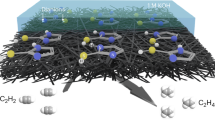Abstract
ORGANO-SILICON compounds containing silanol groups are highly reactive, undergoing acid- or base-catalysed condensation to form siloxanes even in the presence of surface acid or base, the condensation being more facile in the order ≡SiOH < = Si(OH)2 < −Si(OH)3 By the use of plastic, quartz or washed borosilicate glass apparatus, several alkyl and aryl silanols and silane diols have been isolated1–3. But only aromatic silane triols (R.Si(OH)3) have been isolated3, the corresponding alkyl derivatives being known only as transient species in solution. We report here that certain organo-silane triols display outstanding stability in aqueous solution.
This is a preview of subscription content, access via your institution
Access options
Subscribe to this journal
Receive 51 print issues and online access
$199.00 per year
only $3.90 per issue
Buy this article
- Purchase on Springer Link
- Instant access to full article PDF
Prices may be subject to local taxes which are calculated during checkout
Similar content being viewed by others
References
Kantor, S. W. J. Am. chem. Soc. 75, 2712–4 (1953).
Hyde, J. F. J. Am. chem. Soc. 75, 2166–7 (1953).
Takiguchi, T. J. Am. chem. Soc. 81, 2359–61 (1959).
Iler, R. K. The Colloid Chemistry of Silica and Silicates (Cornell University Press, Ithaca, 1955).
Author information
Authors and Affiliations
Rights and permissions
About this article
Cite this article
BIRCHALL, J., CAREY, J. & HOWARD, A. Silane triols of high stability in aqueous solution. Nature 266, 154–156 (1977). https://doi.org/10.1038/266154a0
Received:
Accepted:
Issue Date:
DOI: https://doi.org/10.1038/266154a0
This article is cited by
-
Observations on modifying particle formation in the hydrolysis of titanium (IV) tetra-ethoxide
Journal of Materials Science Letters (1990)
Comments
By submitting a comment you agree to abide by our Terms and Community Guidelines. If you find something abusive or that does not comply with our terms or guidelines please flag it as inappropriate.



